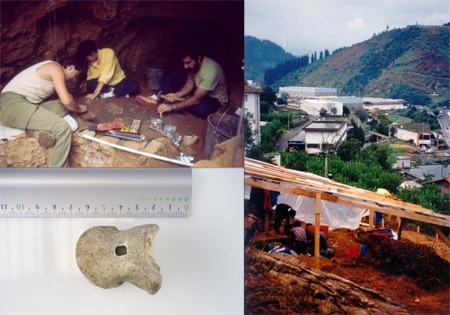Un estudio internacional publicado en la Revista Nature, y en el que han participado investigadores de la UPV-EHU, ha retrasando en unos 10.000 años la extinción de los neandertales. De tal forma que estos pudieron llegar a convivir con los «humanos modernos» hasta 5.000 años en Europa. El estudio determina que ambas especies coexistieron entre 25 y 250 generaciones. Lo que implica que se produjeron intercambios culturales y cruces entre los Neandertales y los Sapiens.
Este estudio, resultado de seis años de trabajo, va a cambiar, por lo tanto, los libros de historia al determinar que, hace 45.000 años Europa estaba habitada principalmente por los neandertales, con escasos grupos de Homo Sapiens . Una relación de cantidad que se invirtió en los siguientes 5.000 años hasta que desaparecieron los primeros.
Una curiosidad: el estudio ya está referenciado en la entrada correspondiente al «Homo neanderthalensis» en Wikipedia, aunque sólo citando a una de las Universidades participantes en el estudio. La correspondiente al director del estudio:
«Por otra parte, el momento preciso de su extinción ha sido motivo de debate y en 2014, Thomas Higham de la Universidad de Oxford estableció que los últimos restos neandertales en Europa eran datables por radiocarbono entre los 41.000 y los 39.000 años, coincidiendo con el inicio de un período de bajada de las temperaturas en el continente europeo, 5.000 años después de que Homo Sapiens iniciara su presencia en el mismo continente»
Y es que resulta muy curioso ver cómo se adjudica el peso de la investigación a unos u otros, en función de la fuente y/o el medio. Lo mismo que resulta curioso el espacio de tiempo que ha pasado desde que Nature World News (National Geographic) recogiera la información (en abril) y cúaldo lo han hecho la mayoría de los medios (agosto)
Journal of Human Evolution – 4/2014 – USA
The chronology of the earliest Upper Palaeolithic in northern Iberia: New insights from L’Arbreda, Labeko Koba and La Viña
Since the late 1980s, northern Iberia has yielded some of the earliest radiocarbon dated Aurignacian assemblages in Western Europe, probably produced by anatomically modern humans (AMHs). This is at odds with its location furthest from the likely eastern entry point of AMHs, and has also suggested to some that the Châtelperronian resulted from cultural transfer from AMHs to Neanderthals.
(Sigue) (Traducción automática)
———————————-
Nature World News -14/4/2014 – USA
Neanderthals, First Humans did not Meet on Iberian Peninsula

n international team of university researchers has concluded that a meeting between a Neanderthal and one of the first humans did not take place on the Iberian Peninsula, according to a release from the University of the Basque Country. This was the determination made after re-dating the remains in three caves located on the route through the Pyrenees of the first beings of our species: L’Arbreda, Labeko Koba, and La Vina.
(Sigue) (Traducción automática)
———————————-
Ámbito Financiero – 20/8/2014 – Argentina
Humanos modernos y hombre de Neandertal llegaron a convivir
Los neandertales compartieron el hábitat de Europa con los humanos modernos durante cinco milenios hasta que desaparecieron hace 40.000 años, un tiempo de cohabitación suficiente como para que se produzcan intercambios culturales y cruzas, según investigadores.
(Sigue) (Traducción automática)
———————————-
India Updates – 22/8/201 -India
A Study Shows That Neanderthals And Sapiens Lived For 5,000 Years
A study by scientists at the University of the Basque Country (UPV / EHU) has been published in Nature has changed prehistory books, rolling back some 10,000 years the extinction of Neanderthals. The results suggest that the disappearance of the Neanderthals in Europe and the end of the Mousterian culture makes occurred between 41,000 and 39,000 years along fields extending from the Black Sea to the Atlantic coast. Similarly, the study concludes that and exhibits a much more complex map, characterized by a biological and cultural mosaic that lasted several thousand years.
(Sigue) (Traducción automática)
———————————-
BBC -20/8/2014 – Gran Bretaña
New dates rewrite Neanderthal story
Modern humans and Neanderthals co-existed in Europe 10 times longer than previously thought, a study suggests. The most comprehensive dating of Neanderthal bones and tools ever carried out suggests that the two species lived side-by-side for up to 5,000 years. The new evidence suggests that the two groups may even have exchanged ideas and culture, say the researchers. The study has been published in the journal Nature.
(Sigue) (Traducción automática)
———————————-
AOL – 20/8/2014 -USA
Neanderthals and humans had ‘ample time’ to mix, new study says
Humans and Neanderthals may have coexisted in Europe for more than 5,000 years, providing ample time for the two species to meet and mix, according to new research. Using new carbon dating techniques and mathematical models, researchers examined about 200 samples found at 40 sites from Spain to Russia, according to a study published Wednesday in the journal Nature. They concluded with a high probability that pockets of Neanderthal culture survived until between 41,030 and 39,260 years ago. Although this puts the disappearance of Neanderthals earlier than some scientists previously thought, the findings support the idea that they lived alongside humans, who arrived in Europe about 45,000-43,000 years ago.
(Sigue) (Traducción automática)
———————————-
Last Updated on Ene 31, 2015 by About Basque Country
































Información Bitacoras.com
Valora en Bitacoras.com: Un estudio internacional publicado en la Revista Nature, y en el que han participado investigadores de la UPV-EHU, ha retrasando en unos 10.000 años la extinción de los neandertales. De tal forma que estos pudieron lleg…